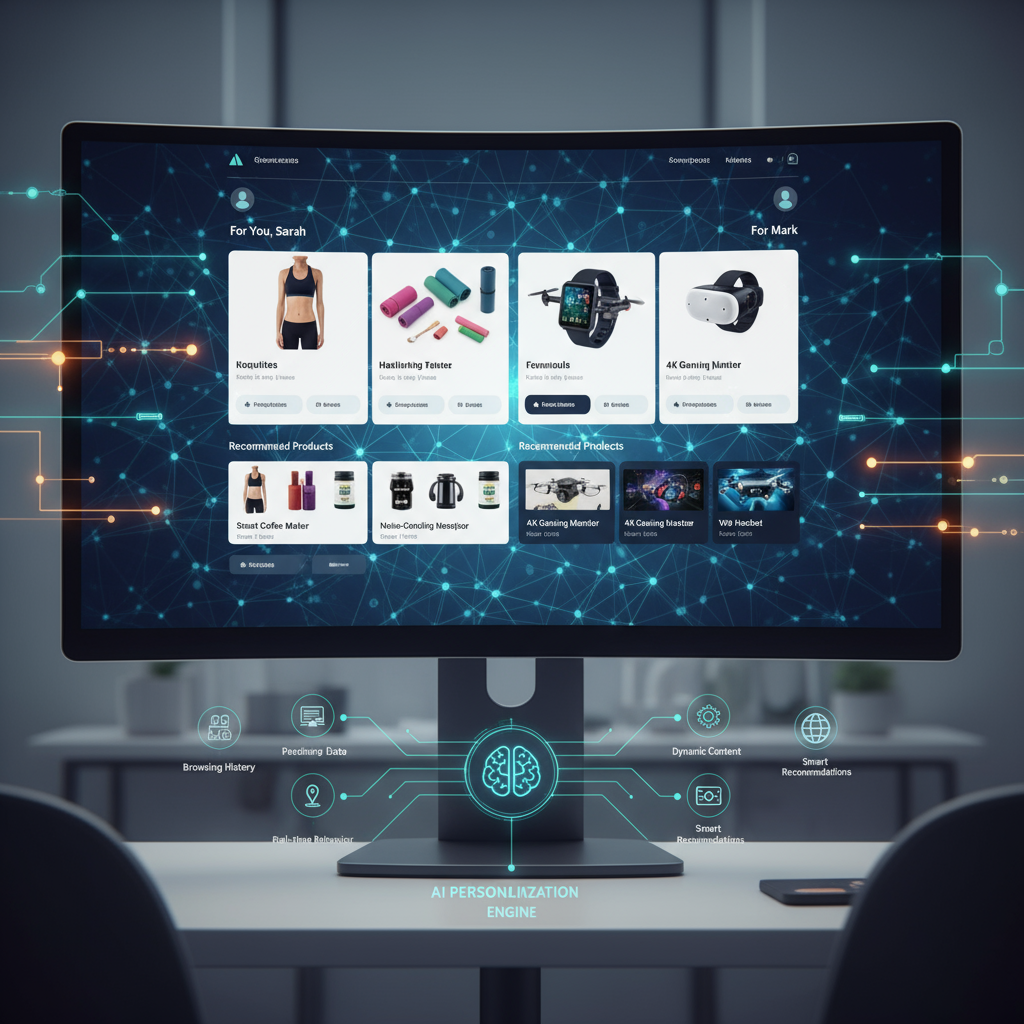Introduction: Navigating the Future of Ecommerce
The current ecommerce trends for 2025 are reshaping how brands connect, convert, and build loyalty. Online retail is no longer just about transactions—it’s about anticipating consumer expectations, using technology intelligently, and balancing growth with trust.
This guide explores the most important ecommerce shifts of 2025, from generative AI to sustainability, social commerce, and immersive technologies that retailers of any size can adapt.
For deeper insights on content planning, see The Ultimate E-Commerce Content Creation Guide.
1. Generative AI Powers Personalization
AI has moved beyond predictive analytics into generative experiences, shaping product discovery, customer service, and marketing. Businesses using advanced personalization see a 10–15% revenue lift (McKinsey).
Brand examples:
- Amazon attributes 35% of sales to AI-powered recommendations.
- Sephora uses AI to match products with individual profiles through its Color iQ tool.
- Stitch Fix blends algorithms with stylist curation to ship personalized clothing boxes.
Smaller retailers don’t need to reinvent the wheel—AI tools built into Shopify or apps like Nosto can create tailored recommendations, while generative AI can personalize email subject lines or even landing pages. The effect is a shopping journey that feels unique at scale.

2. Voice and Conversational Commerce Ecommerce Trends
The rise of smart assistants is fueling voice-driven shopping. With more than 500 million smart speakers worldwide (Statista), consumers increasingly expect to place orders using voice commands.
Brand examples:
- Walmart integrates with Google Assistant so shoppers can add groceries hands-free.
- Domino’s voice ordering with Alexa cut order time by 30%.
- Target enables reordering through Siri and Alexa integrations.
For smaller brands, voice commerce highlights the importance of optimizing product descriptions for natural, conversational queries. Even adding a WhatsApp Business chat or Messenger bot can mirror the frictionless feel of conversational commerce without heavy development costs.


3. Mobile Commerce Becomes the Core
In 2025, mobile is the dominant channel, accounting for over 70% of global ecommerce purchases (Insider Intelligence).
Brand examples:
- Nike’s app-led strategy drives product drops, loyalty rewards, and AR try-ons, fueling billions in direct sales.
- Shein relies on a mobile-first design and fast app updates to keep Gen Z engaged.
- Starbucks leverages mobile ordering, rewards, and wallet integration, proving convenience drives loyalty.
For other retailers, these ecommerce trends underscores the value of progressive web apps (PWAs) and one-click payment integrations. Even without a custom app, mobile-optimized checkout and SMS marketing campaigns can significantly lift conversions

4. Social Commerce Turns Likes into Purchases
Social media has become a full-fledged sales channel. By 2025, global social commerce sales are expected to exceed $1.2 trillion (Accenture).
Brand examples:
- TikTok Shop integrates product listings directly into live streams, driving impulse buys.
- Instagram Checkout allows users to buy without leaving the app.
- Gymshark uses influencers and UGC campaigns to fuel rapid growth across platforms.
The lesson here is clear: consumers expect to shop where they scroll. Smaller retailers can experiment with shoppable Instagram posts, TikTok challenges, or live product demos, converting engagement into direct revenue.

5. AR, VR & Immersive Shopping
Immersive experiences are now a competitive edge, not a futuristic dream. Shoppers want to see, try, and interact virtually before buying.
Brand examples:
- IKEA Place app lets customers visualize furniture in their rooms, reducing returns.
- Warby Parker offers virtual try-ons for eyewear, boosting online confidence.
- Gucci experimented with VR showrooms and AR filters, turning digital into luxury.
Retailers at any level can integrate lighter AR features using Shopify plugins or Meta’s Spark AR. Even simple product videos with 360° views provide a richer experience than static images.

6. Sustainability as a Differentiator
Consumers increasingly expect brands to align with their values. A Deloitte survey found 57% of shoppers are willing to change buying habits to reduce environmental impact (Deloitte).
Brand examples:
- Patagonia promotes its resale program “Worn Wear,” encouraging reuse.
- Allbirds highlights carbon footprint labels on every product.
- ThredUp grew into a billion-dollar resale marketplace, capitalizing on recommerce.
Eco-friendly packaging, carbon-neutral shipping, and resale programs aren’t just ethical—they’re profitable. Starting small with recyclable packaging or transparent sourcing can build trust and stand out in crowded markets.
7. Omnichannel and Logistics Innovation
Omnichannel is no longer optional. By 2025, 70% of consumers expect seamless channel experiences .
Brand examples:
- Walmart leads with curbside pickup and same-day delivery.
- Best Buy integrates online browsing with local inventory visibility.
- Zara uses RFID to unify stock across digital and physical stores.
Emerging retailers can mirror these models by partnering with logistics providers offering BOPIS (buy online, pick up in-store), or using distributed fulfillment networks to reduce shipping times.
8. Security, Privacy & First-Party Data
Trust is a non-negotiable. With GDPR, CCPA, and similar regulations expanding, brands must balance compliance and customer loyalty.
Brand examples:
- Apple’s privacy-first positioning reshaped consumer expectations around data.
- Shopify enables merchants to build first-party data pipelines via email and loyalty programs.
- PayPal and other payment providers strengthen biometric authentication.
For most retailers, the takeaway is to focus on first-party data collection—through email, SMS, and loyalty schemes—while communicating clearly about data use to reassure shoppers.
9. Video Commerce and Content-Led Conversions
Video is now central to discovery and decision-making. Research shows 84% of people say they’ve been convinced to buy after watching a brand video (Wyzowl).
Brand examples:
- TikTok Shop Live converts entertainment into sales in minutes.
- Amazon Live integrates shopping with influencer-led live streaming.
- Glossier uses behind-the-scenes videos to deepen community connection.
For smaller retailers, even short-form Instagram Reels or YouTube Shorts showcasing products in use can increase conversion rates significantly.

Summary Table: Ecommerce Trends in 2025
| Trend | Why It Matters | Example Brands | What Others Can Learn |
|---|---|---|---|
| Generative AI | Personalization lifts revenue 10–15% | Amazon, Sephora, Stitch Fix | Start with AI tools for recommendations, emails |
| Voice Commerce | 500M+ smart speakers in use | Walmart, Domino’s, Target | Optimize for natural queries, enable chat shopping |
| Mobile Commerce | 70%+ of ecommerce via mobile | Nike, Shein, Starbucks | Use PWAs, one-click checkout, SMS |
| Social Commerce | $1.2T sales projected | TikTok, Gymshark, Instagram | Create shoppable posts, live streams |
| AR/VR | Reduces returns, boosts engagement | IKEA, Warby Parker, Gucci | Add AR try-ons or 360° product views |
| Sustainability | 57% shift to eco-brands | Patagonia, Allbirds, ThredUp | Eco packaging, resale, transparency |
| Omnichannel | 70% expect seamless shopping | Walmart, Best Buy, Zara | Enable BOPIS, unify inventory |
| Security & Privacy | Regulations expanding | Apple, Shopify, PayPal | Build first-party data, clear policies |
| Video Commerce | 84% buy after watching video | TikTok, Amazon Live, Glossier | Short-form demos, behind-the-scenes |
Final Thoughts
The current ecommerce trends in 2025 point to one conclusion: growth favors the adaptive. From AI-driven personalization to immersive tech and sustainability, brands that combine innovation with customer trust will lead the market.
